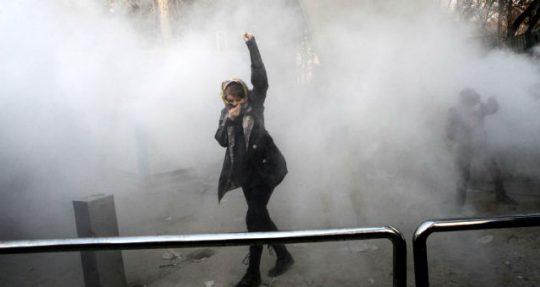"No to Gaza, no to Lebanon, my life for Iran!"
"Let go of Syria; think about us!"
The Iranian people began bellowing these chants across Iran in late December 2017, when anti-government protests erupted nationwide. On the surface, the demonstrations—which continue still, despite the Western media's indifference—appear to stem from economic grievances. Indeed, the theocratic regime's corruption and incompetence has led to an economic crisis in Iran, which American sanctions have exacerbated. Fundamentally, however, the protests are political, not economic. It took little time for anger about surging prices and deepening poverty to become anger about the Islamic Republic's brutal rule. Iranians chanted in the streets "death to dictator" and "our enemy is here, but they always say it is America." The protesters also made clear through their chants that they do not just oppose the regime's internal oppression, but also its imperial foreign policy across the Middle East. Understanding this point is the key to exerting maximum pressure on Iran's leadership.
It is easy to see why Iranians are fed up with their government's foreign policy. The regime seeks preeminence in the Middle East. It exerts heavy influence on Arab capitals in Iraq, Lebanon, Syria, and Yemen; incites the Shi'ite populations in Bahrain and Saudi Arabia to subvert their governments; supports Palestinian terrorist groups; and oversees networks of militias throughout the region that answer to Tehran. Iran seeks to build a continuous corridor of political and military control, from its Afghan border to the Mediterranean Sea, to exert influence across the Middle East.
This project requires billions of dollars each year—the regime gives Hezbollah, its chief proxy force in Lebanon, about $700 million alone—that could be used to alleviate the Iranian people's economic woes. Moreover, such an expansionist foreign policy, which involves supporting terrorist groups and abusing human rights, provokes sanctions from the United States and other countries. The Iranian people see no benefit from such imperialism, only an ideological agenda that hurts them in the end.
It should not be surprising, then, that on Tuesday, Iranians in the city of Andimeshk tore down a large billboard showing members of Iran's Islamic Revolutionary Guard Corps who were killed in Syria, where the regime has deployed thousands of men to keep President Bashar al-Assad in power. Videos posted on social media showed Iranians cheering and celebrating as the billboard fell to the ground. The incident was clearly a protest against Iran's involvement in the Syrian conflict.
https://twitter.com/HeshmatAlavi/status/1097859594691465218?ref_src=twsrc%5Etfw%7Ctwcamp%5Etweetembed%7Ctwterm%5E1097859594691465218&ref_url=https%3A%2F%2Fwww.jpost.com%2FMiddle-East%2FAngry-Iranians-tear-down-image-of-Iranian-forces-killed-in-Syria-report-581151
https://twitter.com/HeshmatAlavi/status/1097865713145073669?ref_src=twsrc%5Etfw%7Ctwcamp%5Etweetembed%7Ctwterm%5E1097865713145073669&ref_url=https%3A%2F%2Fwww.jpost.com%2FMiddle-East%2FAngry-Iranians-tear-down-image-of-Iranian-forces-killed-in-Syria-report-581151
The regime's foreign policy has unquestionably helped fuel the protests across Iran. This connection gets at the crucial element needed to pressure Tehran—an element that is now missing from the Trump administration's strategy toward the Islamic Republic.
After withdrawing the U.S. from the Iran nuclear deal last year, the administration's approach to the Islamic Republic became straightforward: exert maximum pressure on the regime to bring it back to the negotiating table. The unclear part is what comes next. Will the administration pursue a new agreement narrowly focused on the nuclear issue, or will it seek a broader deal? In May, Secretary of State Mike Pompeo listed 12 demands of Iran that are necessary for a new agreement. These items go well beyond Iran's nuclear program, from calling on the regime to end support to terrorist groups to requiring Tehran to withdraw all Iranian forces from Syria. Will the U.S. only agree to talks if Iran adheres to all 12 items? Regardless of how broad the deal is, just forcing Iran back to negotiate anything will require serious pressure.
Victoria Coates, the senior director for the Middle East on the National Security Council, made clear in a post last week that sanctions are the core of this policy. "Under the president's direction, we have prioritized the maximum pressure campaign placing unprecedented stress on Iran's economy, forcing Tehran to make increasingly difficult choices," she wrote.
Sanctions are certainly necessary, but they are also insufficient. A true campaign of pressure needs to counter Iran's aggression beyond its borders and support the Iranian people's protests inside their country. Coates even acknowledged that "there is more we can do to roll back Iran's activities within its borders and in the region." The U.S. can address both simultaneously.
The Trump administration can and should intensify the protests inside Iran by challenging the regime in the Middle East. No large-scale military deployments are required. The U.S. just needs to launch a sustained campaign, in cooperation with regional allies, to raise the costs on Iran to continue its foreign adventures across the region. Force Tehran to send more men and spend more money in places like Syria and Yemen. This will further anger the Iranian people and lead to more internal turmoil, which the regime fears the most. Tehran may decide to double down on its regional ambitions, but it has shown that it can scale back external aggression in the face of domestic trouble.
Add increasingly harsh sanctions to the mix, and the regime just may feel enough pressure to engage Washington. Or, Trump can keep the pressure going, and test just how strong the regime in Iran really is.
